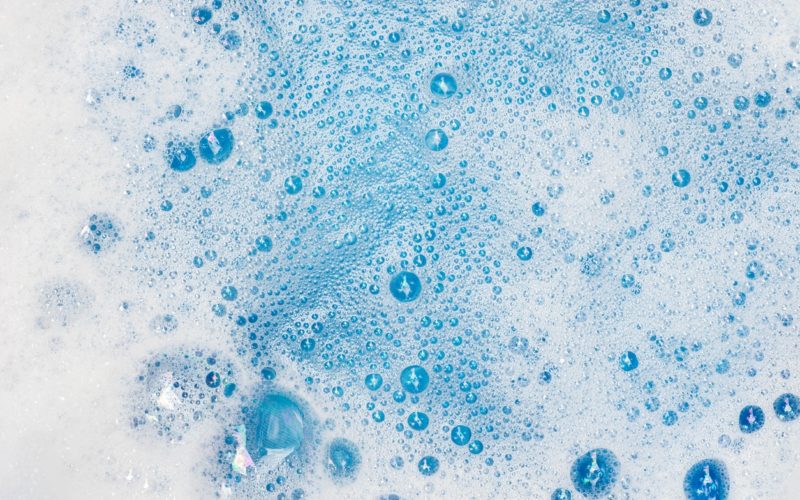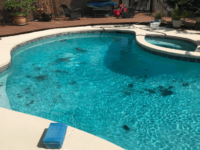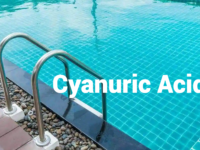The great news is that having a foamy pool is not the end of the world. Compared to other problems, this one is easy to solve. Read our detailed guide on how to make your pool crystal clean again and prevent foam formation in the future.
The problem of the foam in your pool
You wake up one day and notice a layer of white foam or bubbles on the water surface. It makes the water feels “thick” and uncomfortable to swim. Many owners are familiar with it. Especially, after using an algaecide or having a big pool party recently.
Don’t be afraid! The foam is not dangerous, however, it is a sign that something is wrong with the pool maintenance or the pumping system. If you get this issue, you should find out what causes this problem to address it quickly and take preventive measures in the future.
In this article, I have highlighted the Top-5 reasons why you can have the foam, how to get rid of it and how to prevent it. So, keep reading and you will find the solution.
Check the pool balance before cleaning
Before you start doing anything else, test your pool. You need to ensure that your chemicals are balanced. Use a test kit to check the pH, calcium hardness, chlorine level, and alkalinity.
The results for a balanced pool are
| Indicator | Acceptable result |
| pH | 7.4 – 7.6 |
| Total Alkalinity (TA) | 80 -120 ppm |
| Calcium hardness (CH) | 150-400 ppm |
| Total chlorine | 1.0 – 3.0 ppm |
The chemical imbalance is one of the five most popular causes of the pool foam. If you have it, go right to the section about the solution.
5 reasons why your pool has foam and how to get rid of it
Depending on the cause, the sequence of your actions may be different. I covered the most common causes of the “thick” water.
You used algaecide of poor quality or overdosed on it
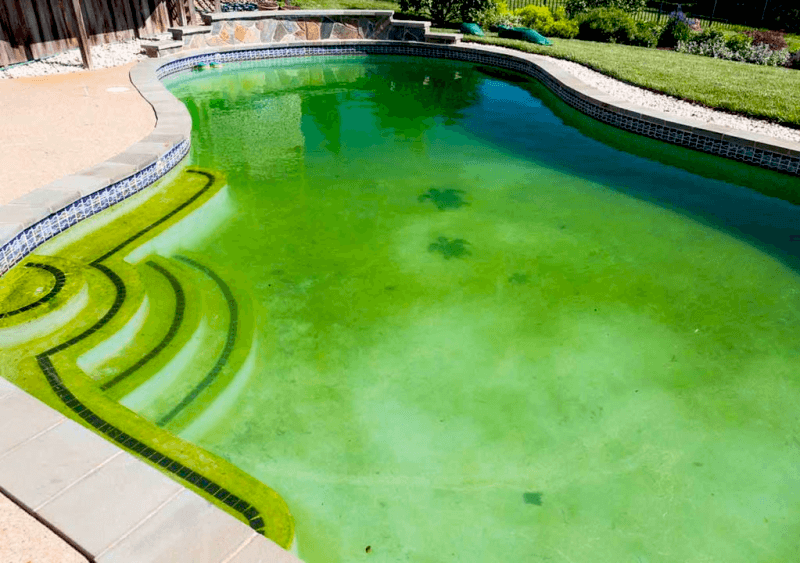
😒 Problem: In 90% of cases, the usage of poor quality algaecide or its overload becomes a reason for the foam. Algaecide is a regularly used chemical that prevents algae growth. However, if there are no algae to destroy, the algaecide makes water “thick” and forms foam. Moreover, cheap algaecides cause foam formation too. Check the bottle of your algaecide for the percentage of polymers and metals containment or the “non-foaming” inscription. Cheap algaecides contain about 10% of polymers and contain copper or other metals, thus causing foam.
😏Solution: If you overdo chemicals the easiest solution is to wait. Foam will disappear in a few days. To speed up the process you should use a skimmer to clean the water surface. You can also shock the pool, however, this step is not necessary. Another solution is to drain some water from the pool and refill it with fresh to dilute the chemicals. After draining, use a pool testing kit to balance the pool.
💡How to prevent it: First of all, check the ultimate and step-by-step guide on how to use algaecide safely. Moreover, buy high-quality non-foaming algaecide. It should contain from 30% to 60% of polymers and goes without copper or other metals.
You had many swimmers in the pool recently
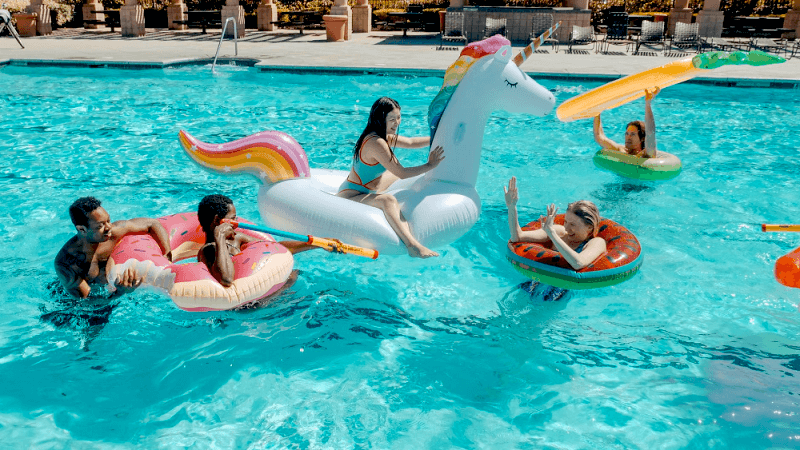
😒 Problem: You cannot imagine how many chemicals every person brings to the pool. On a day-to-day basis, we use deodorants, shampoo, conditioner, body lotion, and other cosmetics to keep ourselves clean and beautiful. However, while jumping right into the pool all these chemicals enter the water, increasing the number of organic compounds. That makes water “thick”. Moreover, swimsuits and trucks contain residues of washing detergents and soap, which cause foam too. Multiply these factors by the number of swimmers and you will get the reason for the foam.
😏Solution: Firstly, use a skimmer and clean the water surface. Secondly, shock the pool. To do it, follow the next steps.
Hint! Shock the pool when the sun goes down, as the UV destroys the chlorine making it less effective.
- Protect yourself. Take goggles, chemical-resistant gloves, pants, a long-sleeved shirt and closed-toe shoes.
- Balance pH, alkalinity, and calcium hardness before shocking to make the process more effectively.
- Carefully read instructions on the shock product. Calculate and dissolve the amount of the shock according to the pool volume.
- Turn on the pool pump and filter to the full speed and add the shock. Walk around the pool slowly pouring the same portions of shock solution.
- Keep the system working for at least 8-12 hours.
- Enjoy clean water.
Safety tips:
- Strictly follow the instructions
- Wear a protective cloth
- Do not deeply breathe in the smell from shock solution
💡How to prevent it: Set the rule that everyone should take a short shower before entering the pool. This will wash out cosmetics and detergents from the body and cloth.
Chemical imbalance
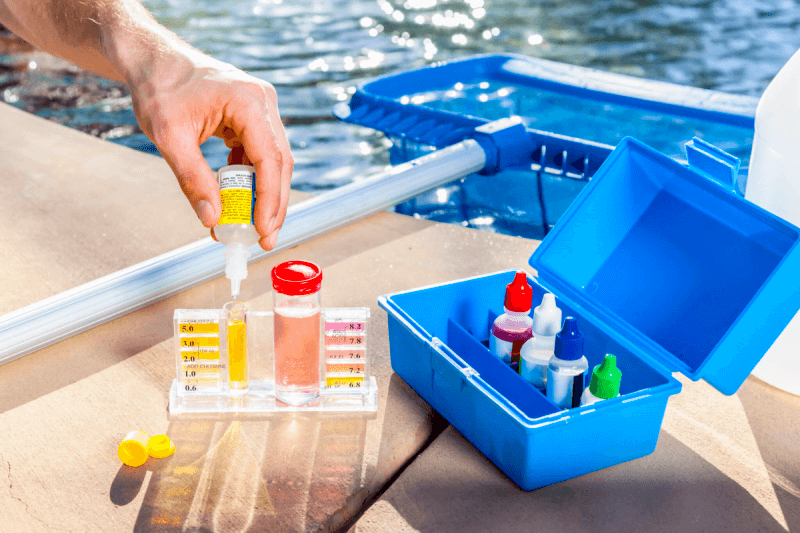
😒 Problem: While your pool is imbalanced you probably get problems with foam, cloudy water, or algae. Usually, foam is associated with a low calcium hardness (below 150 ppm). The soft water tends to foam.
😏Solution: Separately adjust pH, calcium hardness, and total chlorine in this order. To increase calcium hardness, add the calcium chloride to the pool. Left the pool pomp running at least for a day, and you will probably get rid of the foam.
💡How to prevent it: Test the water regularly on pH, calcium hardness, chlorine level, and alkalinity as they indicate the pool’s ‘health’. To get accurate results I recommend you to use high-quality test kits.
Increase of Total Dissolved Solids (TDS) level
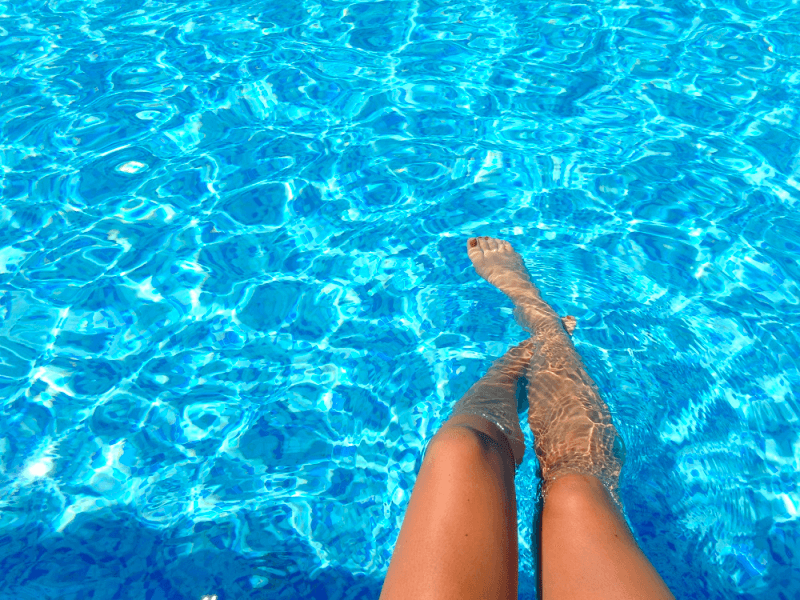
😒 Problem: Total Dissolved Solids (TDS) level indicates how many solids are present in water. This measurement includes both good and harmful solids. The list is not limited to magnesium, calcium, pesticides, copper, sodium, chlorine, herbicides, etc. A TDS level of 2000 ppm is a maximum acceptable level for comfortable swimming. Water with the level above is salty, starts to foam and causes skin and eye irritation. High TDS also decreases the sanitizer efficiency. This parameter increases over time due to adding chemicals, evaporation, and environmental impacts such as falling leaves, rains, and soil.
😏Solution: The most effective solution is to drain some water and refill the pool with the fresh. This will dilute chemicals in the water and you get rid of the foam.
💡How to prevent it: To control the TDS level you can buy a TDS-meter, a specific test kit or give water for the laboratory analysis. I recommend measuring the TDS level in water just after you fill the pool and then monitoring it periodically. When the level reaches 1000 ppm over the start, it is time to drain the pool. This will prevent issues with clean maintainance, corrosion, foam, and unpleasant odor. Moreover, to keep TDS low ensure that the filtration system is working smoothly and run it at least 8 hours per day.
Air leaks in the pump system
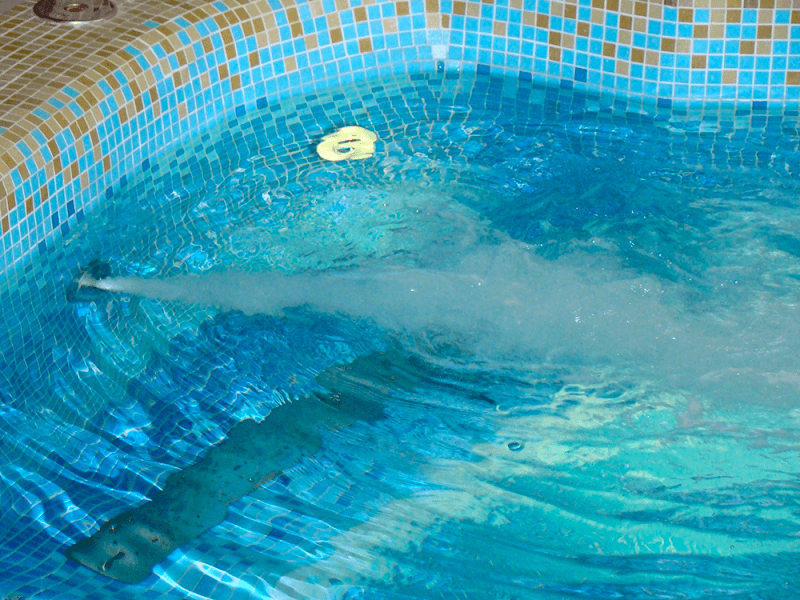
😒 Problem: One possible reason is the problems with air leaks in the pumping system. In that case, the water has foam, but does not feel “thick”. Air in the pump system prevents the pump from running at full prime and causes issues in the circulation system.
😏Solution: The most common reasons why the air sucks into the pumping system are the low level of the water and the loose connections between the system elements. Check whether you have one of these:
- The skimmer drains in water for less than a half. As a result, it sucks the excess air that enters the pumping system. Add the water to the pool to level from half to a third-quarter of the skimmer.
- The stainer pot lid isn’t on tight. The stainer pot is the first part of the pump. Its function is to catch debris. The lid should be tightly close to the stainer pot, otherwise, the pump will suck the air. To check it:
- Turn off the pool pump;
- Take the lid off;
- Check the O-ring. It should be located in its groove, has no damage, and no dirt or debris should block tight attachment to the strainer.

- The pump/valve union is not tight. There is a union between the pump and the valves. It also contains the O-ring for the tight connection. To check this part you need.
- Turn off the pool pump;
- Remove the net over the union;
- Check the O-ring. It should be located in its groove, has no damage, and has no dirt or debris on it.
These issues are minor, so every pool owner can handle them. If you see the pumping system damaged and you do not know how to fix it, it is better to call the pool services.
💡How to prevent it: Keep your pool pump well maintained and check it regularly for any leaks. Here are a few tips on how to care about the pump to prolong its lifespan:
- The level of the water should be at least halfway to the skimmer height
- Empty the skimmer basket every couple of days
- Empty the filter from hair and lint at least every two weeks
- Secure seal between the stainer pot lid and the stainer by cleaning the contact surfaces and O-ring as well as lubricating the O-ring.
- If you see water leaks or the pump starts to whistle or to hum as it did not do before, immediately call a professional service
Get your water clean in an hour
When you have an urgent situation, use the de-foamer. It starts working from the first minutes after the addition and removes any sign of the foam. The de-foamer doesn’t affect any chemicals in the pool.
Notice, that the de-foamer treats only the foam, and doesn’t address the cause of the problem. It will work fine if the issue is the overloading of hair and skin products. On the other hand, if the foam is caused by high TDS or chemical imbalance, the de-foamer dissipates the foam, but it will return in the future.
What if nothing helps?
If you still have a foam after addressing all points from the article, I suppose the cause of your problem lies deeper. Maybe the part of the pool is broken or damaged.
In this case, you would better contact professionals from the pool service.
Summary
There is several possible reasons why your pool gets foamy, including an overload of algaecide, the cosmetics and chemicals swimmers bring in, imbalanced chemicals, and air leaks in the pump system.
The first step to understanding the reason for the foam is to check the chemicals and adjust its level if it is not balanced. You may also need to shock the pool. Sometimes you also should check and repair the pumping system to prevent air leaks.
As with every pool issue, the pool foam is easier to prevent, than to treat. So watch for the pool, and you will never have the foam again.
FAQ
🏊 Is it safe to swim in the pool with foam?
Check the balance of your water. If it is OK, then it is safe. The presence of the foam has nothing with microbiological contamination or infection. However, if the issue is a high TDS level, swimming can cause skin and eye irritation.
💚 How to treat foam after adding the algaecide?
If you overdosed on the algaecide, the foam will dissipate in a few days. To speed up the process, clean the water surface with the skimmer. You may shock the pool to break algaecide down quicker, however, it is an unnecessary step.
💫How to quickly get rid of foam?
Use a de-foamer to dissipate the foam. You will get the pool clean in an hour. Keep in mind that this chemical will treat only the foam, not the cause, so use it only in urgent situations. If the foam returns after using the de-foamer, spend your time finding the reason.
💨What to do with the foamy and cloudy pool?
Having cloudy water with foam on the surface usually means that your pool chemistry is imbalanced. So check it first and treat the water accordingly. If the chemicals are balanced, another common reason is a problem in the filtration system and possible air leakage. Check the article about cleaning cloudy water.
😄How to prevent the pool from foaming?
There are 4 easy-to-follow tips:
– ask all swimmers to take a shower before getting into the pool
– use non-foaming algaecide with no-cooper
– keep pool balance and TDS level under 2,000 mg/L
– check the pumping system for air leaks and repair it on time
